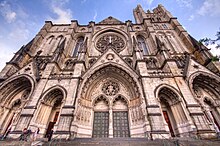Emlen T. Littell
Emlen Trenchard Littell (February 12, 1838 – March 4, 1891) was an American architect known for designing Gothic Revival style churches.
[7] Although both architects became noted for designing churches, their partnership only lasted through 1860, with Little establishing an independent practice in 1861.
[6][1] After the Civil War, Charles Coolidge Haight worked with Littell to receive training and experience, before leaving to start his successful practice in 1867.
[8][9] In 1867, he formed a practice with Henry Hobson Richardson in the Trinity Building at 111 Broadway in Manhattan.
In the city or undulating country, the lofty spires should mark its location, breaking the skyline with their sharp, cross-surmounted peaks.
[14] Comfort was also important for both physical and practical reasons; he said, "The uneasiness of the body necessarily distracts the mind from worship, and every ancient or modern appliance which provides fresh air, full light, gentle heat, et cetera, should be faithfully used to the end that the congregation shall not undergo unwilling penance.
Then, as a natural sequence of true comfort, our churches will be healthful, and hereafter darkness, dampness, and foul air will not depress the vital powers and sow the seeds of disease.
[19] Planned as a Gothic style cathedral for a northern diocese, St. John's featured local dark-blue sandstone with trim of light-buff Ohio freestone, Tiffany stained glass windows, and a roof of red, purple, and green Vermont slate.
[25] He also designed the parish house and Sunday school building for the Cathedral Church of St. John in Wilmington, Delaware.
"[28][29] In 1880, he designed a memorial tower and spire to add to St. John's Episcopal Church in Hagerstown, Maryland.
[30] In April 1880, Littell designed an apartment building and four houses for 54th Street, between 6th and 7th Avenue in New York City.
[34] Little designed the Battle of Monmouth Monument for Freehold, New Jersey, with New Yorkers Douglas Smythe and sculptor James E.
[39] His presentation was on "The Use and Abuse of Brick in Decoration" at the twelfth annual AIA convention on November 13, 1878.
[43] He was also a founding member of the New York Chapter of AIA in 1867 and served as the group's president for three terms, from 1879 to 1884 and from 1890 to his death in 1891.
[44] In 1889, he served on a chapter committee to select and purchase plaster reproductions of architectural details and works for the Metropolitan Museum, such as a model of the Parthenon.
[47][48] New Yorker Levi Hale Willard left a bequest of $100,000 to the museum in 1893 to purchase "a collection of models, casts, photographs, engravings, and other objects illustrative of the art and science of architecture.



